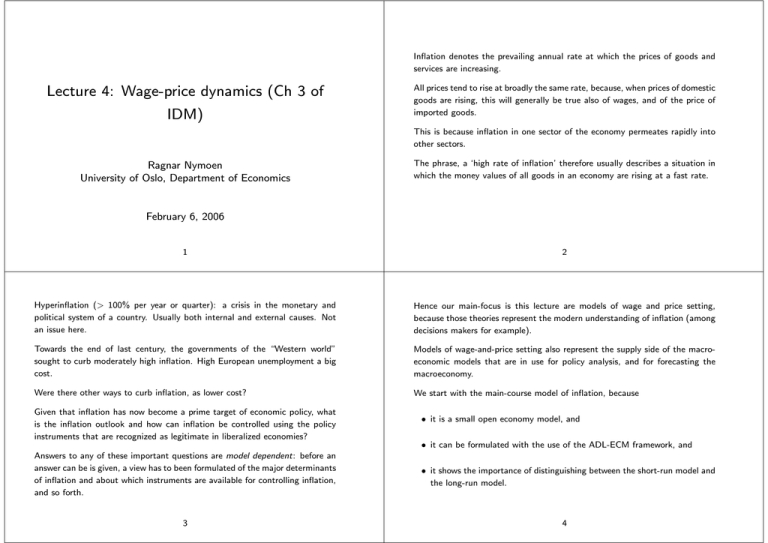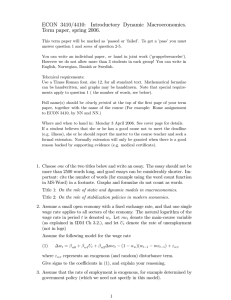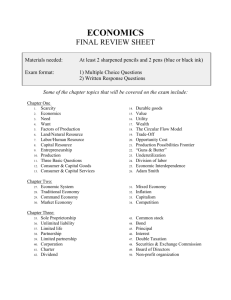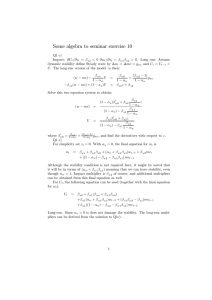Inflation denotes the prevailing annual rate at which the prices... services are increasing.
advertisement

Inflation denotes the prevailing annual rate at which the prices of goods and
services are increasing.
Lecture 4: Wage-price dynamics (Ch 3 of
IDM)
All prices tend to rise at broadly the same rate, because, when prices of domestic
goods are rising, this will generally be true also of wages, and of the price of
imported goods.
This is because inflation in one sector of the economy permeates rapidly into
other sectors.
Ragnar Nymoen
University of Oslo, Department of Economics
The phrase, a ‘high rate of inflation’ therefore usually describes a situation in
which the money values of all goods in an economy are rising at a fast rate.
February 6, 2006
1
2
Hyperinflation (> 100% per year or quarter): a crisis in the monetary and
political system of a country. Usually both internal and external causes. Not
an issue here.
Hence our main-focus is this lecture are models of wage and price setting,
because those theories represent the modern understanding of inflation (among
decisions makers for example).
Towards the end of last century, the governments of the “Western world”
sought to curb moderately high inflation. High European unemployment a big
cost.
Models of wage-and-price setting also represent the supply side of the macroeconomic models that are in use for policy analysis, and for forecasting the
macroeconomy.
Were there other ways to curb inflation, as lower cost?
We start with the main-course model of inflation, because
Given that inflation has now become a prime target of economic policy, what
is the inflation outlook and how can inflation be controlled using the policy
instruments that are recognized as legitimate in liberalized economies?
Answers to any of these important questions are model dependent: before an
answer can be is given, a view has to been formulated of the major determinants
of inflation and about which instruments are available for controlling inflation,
and so forth.
3
• it is a small open economy model, and
• it can be formulated with the use of the ADL-ECM framework, and
• it shows the importance of distinguishing between the short-run model and
the long-run model.
4
The main-course model of open economy inflation
(Ch 3.2 of IDM)
The name main-course model captures a central hypothesis of the model,
namely that productivity and foreign prices define the scope for wage growth
in an open economy, the main-course for wage development over time.
As we shall see, the main-course hypothesis is consistent with bargaining models
of wage-setting
A framework for long-run wage and price setting
Central to the model is the distinction between an exposed sector where firms
are price takers, and a non-tradables and sheltered sector where firms set prices
as mark-ups on wage costs.
The model’s long-run propositions are,
1. that e-sector wage growth will follow a long run tendency defined by the
exogenous price and productivity trends in that sector.
It also implies an ECM for wages.
An wage Phillips curve is a special case of the main-course ECM framework
(Lecture 5).
2. If relative wages are to be constant in the long-run, the wage level of the
s-sector needs to follow the same tendency.
Some of you have already encountered the main-course model in the form of
the Scandinavian model of inflation. The Scandinavian model is also a special
case of the main-course model we present
3. The development of the domestic price level will also be influenced by trend
growth in international prices and the productivity trend.
5
6
The first hypothesis, about wage formation in the e-sector, is in many ways
the defining characteristic of the whole framework.
Assume that both Qe and Ae are exogenous variables with a trend-like growth.
We can then formulate what we might call the main-course proposition:
We∗ = MeQeAe,
(1)
We concentrate on spelling out the implications of that proposition in detail.
where We∗ denotes the long-run equilibrium wage level consistent with the twin
Ye: output, measured as value added (fixed prices) in the exposed (e) sector,
assumptions of exogenous price and productivity trends and a constant normal
wage share, denoted Me in (1).
Qe: price (index) of output.
Le: labour input (total number of hours worked),
Using logs, the long-run wage equation for the e-sector becomes:
H1mc:
We: the hourly wage.
The wage share of value added is
WeLe
We
Ye
=
, where average labour productivity is given as Ae =
QeYe
QeAe
Le
By definition, the rate of e-sector profits is
We
QeYe − WeLe
=1−
.
QeYe
QeAe
If there is there is a long-run rate of profit which “needed” to sustain investment
and employment in the e-sector, there is also a long-run sustainable wage-share.
7
we∗ = qe + ae + me,
where an asterisk,∗ denotes a long-run equilibrium value, and we∗ = ln(We∗)
etc.
The marker H1mc indicates that this is the first hypothesis of the theory.
The normal situation is that both qe (foreign price adjustments) and ae (technical progress) increase over time. According to H1mc we∗ is also trending
upwards along a path determined by the so called main-course variable:
mc = ae + qe
8
(2)
It is easy to prove (by citation) that Aukrust meant equation H1mc as a long-run
relationship between the e-sector wage level and the main-course:
log wage level
"Upper boundary"
Main course
The relationship between the “profitability of E industries” and the
“wage level of E industries” that the model postulates, therefore, is
certainly not a relation that holds on a year-to-year basis. At best it is
valid as a long-term tendency and even so only with considerable slack.
It is equally obvious, however, that the wage level in the E industries is
not completely free to assume any value irrespective of what happens
to profits in these industries. Indeed, if the actual profits in the E
industries deviate much from normal profits, it must be expected that
sooner or later forces will be set in motion that will close the gap.
(Aukrust, 1977, p 114-115).
"Lower boundary"
0
time
Therefore, the graphical representation of the main-course theory shows the
actual time series of the wage level,we,t, fluctuating around a growing maincourse, but always inside a wage corridor .
Figure 1: The ‘Wage Corridor’ in the Norwegian model of inflation.
9
10
The main-course proposition H1mc is very similar to the bargaining model of
the ‘wage-curve’ which you have encountered in earlier course, for example
ECON 1310. In distilled form, these models state that
There is nothing in Aukrust’s theory which rules out that the long-run wage
level can change as a result of shocks to the economy. Hence, me is a function
of the rate of unemployment, a plausible generalization of H1mc is represented
by
W
(BM)
= Mw A,
P
where W/P is the real-wage (in a sector, or in the total economy), Mw is a
factor which may depend on the state of the labour market and the generosity
of the unemployment insurance system. In the same way as in the main-course
model A = Y /L (average labour productivity).
The main difference is that the main-course model is explicitly a theory about
a long-run steady state situation. BM is a static model, but is nevertheless
sometimes used as a theory of how wages are set in each period.
The main-course model is also clear that the real-wage should be in terms of
the producer price index Qe, not the consumer price, which is sometimes used
as P in BM applications
H1gmc
we∗ = me,0 + mc + γe,1u,
where u is the rate of unemployment (or its log). We use H1gmc in the following.
As noted there are two other long-run propositions which complete Aukrust’s
theory: a constant relative wage between the sectors (denoted mes ) and the
existence of a normal sustainable wage share also in the s-sector:
H2mc we∗ − ws∗ = mes,
H3mc ws∗ − qs∗ − as = ms
as is the exogenous productivity trend in the sheltered sector. Re-arranging
H3mc, gives
qs∗ = ws∗ − as + ms
which is similar to the ‘price equation’ in today’s terminology.
11
12
Error correction wage dynamics
If e-sector wages deviate too much from the main-course, forces will begin
to act on wage setting so that adjustments are made in the direction of the
main-course.
For the main-course theory to be a realistic model of long-term wage behaviour, it is necessary that (3) has a stable solution, also when mct and ut are
exogenous. Hence, we assume:
0 < α < 1.
Use the error correction transformation from Lecture 3 to obtain
We use the ADL model to represent this:
we,t = β0 + β11mct + β12mct−1 + β21ut + β22ut−1 + αwe,t−1 + εt.
∆we,t = β0 + β11∆mct + β21∆ut
(5)
+ (β11 + β12)mct−1 + (β21 + β22)ut−1 + (α − 1)wet−1 + εt
(3)
There are now two explanatory variables (“x-es”): the main-course variable
mct and ut.
(4)
and
We first assume that both mct and ut are exogenous variables. We will see that
corrective forces are at work even at any constant rate of unemployment. This is
a generalization of the models which has come to dominate the macroeconomic
policy debate, and which take it as a given thing that unemployment has to
adjust to a certain number called the natural rate or NAIRU in order to bring
about inflation stabilization.
∆we,t = β0 + β11∆mct + β21∆ut
(6)
½
¾
β11 + β12
β21 + β22
− (1 − α) we,t−1 −
mct−1 −
ut−1 + εt
1−α
1−α
To reconcile this with the hypothesized long-run relationship H1gmc, we make
use of
β + β22
γe,1 = 21
, the long-run multiplier wrt u,
1−α
13
14
and impose the following restriction on the coefficient of mct−1:
β11 + β12 = (1 − α)
(7)
since the long-run multiplier with respect to mc is unity (according to H1gmc).
Then (6) becomes
∆we,t = β0 + β11∆mct + β21∆ut
n
o
− (1 − α) we,t−1 − mct−1 − γe,1ut−1 + εt
Stable dynamics: Assume ∆mct = gmc and ∆ut = 0 (constant rate of unemployment). Assume disequilibrium in period t − 1:
{we − we∗}t−1 > 0 reduces ∆we,t, which leads to {we − we∗}t < {we − we∗}t−1
in the next period, hence equilibrium correction.
(8)
The short-run multiplier wrt mc is β11, which can be considerably smaller than
unity without violating the main-course hypothesis H1gmc.
The formulation in (8) is an Homogenous ECM, which we can write
0
The economic interpretation of stable main-course dynamics is that nominal
wage-settlements equilibrium correct with respect to
1. changes in price and productivity (and therefore profits), and
∆we,t = β0 + β11∆mct + β21∆ut
− (1 − α) {we − we∗}t−1 + εt
2. to the changing bargaining power (or degree of solidarity) of the workers,
as captured most simply by ut.
15
16
where we∗ is given by the left hand side of the extended main-course hypothesis
H1gmc.
A simulation model of the main-course
2.25
extended main-course
2.20
We can use computer simulation to confirm our conclusions about the dynamic
behaviour of the main-course model. The following three equations make up a
representative main-course model of wage-setting in the exposed sector:
upper-boundary
2.15
solution for we,t
2.10
2.05
lower-boundary
we,t = 0.1mct + 0.3mct−1 − 0.06 ln Ut−1 + 0.6we,t−1 + εw,t,
mct = 0.03 + mct−1 + εmc,t
Ut = 0.005 + 0.01 · S1989t + 0.8Ut−1 + εU,t
(9)
2.00
(10)
(11)
1.95
2003
2004
2005
2006
2007
2008
2009
2010
2011
Figure 2: Simulation of calibrated model
17
18
The main-course model and the Scandinavian model of inflation
Change in ln U t to a regime shift in 1989, that raises the equilibrium rate.
-3.0
The “Scandinavian model” specifies the same three underlying assumptions as
the main-course model: H1mc (we do not need the extended version of the
hypothesis for the point we wish to make here), H2mc and H3mc.
-3.2
-3.4
-3.6
1990
1.9
1995
2000
Solution of we,t
But the distinction between long-run and dynamics is blurred in the Scandinavian model. Hence, for example, the dynamic equation for e-sector wages in
the Scandinavian model is usually written as:
Without regime shift in U t
1.8
∆we,t = β0 + ∆mct,
With regime shift in U t
1.7
(without a disturbance term for simplicity) which is seen to place the restriction
of α = 1 on the ECM for e-sector wage dynamics.
1990
1995
2000
Figure 3: Unemployment and wage resonse to a regime shift in the equilibrium
rate of unemployment in 1989. Simulation of the calibrated model
This implies unstable dynamics. If the wage path is ever pushed off the main
course, it never returns.
In terms of the Typology of Lecture 2 and 3, Scandinavian model is a Differenced data model.
19
20
Main-course inflation
1. Autonomous inflation: φβ00 ,
So far, we have looked at only e-sector wage formation, and not inflation as
such. To sketch the theory’s implication for inflation, we need to invoke the two
remaining building blocks of Aukrust’s model, namely H2mc and H3mc above,
and combine them with H1gmc which has been our focus in this chapter.
2. “Imported inflation”: (φβ11 + (1 − φ))∆qe,t
3. Shock to unemployment: φβ21∆ut
Ch 3.2.7 of IDM gives a simplified reduced form inflation equation as:
∆pt = φβ00
(12)
+ (φβ11 + (1 − φ))∆qe,t+
4. Productivity growth: φβ11∆ae,t − φ∆as,t,
+ φβ11∆ae,t − φ∆as,t
5. e-sector equilibrium correction: −φ(1−α) {we.t−1 − mct−1 − γe1ut−1 − me0}
+ φεt
6. random shocks: φεt
− φ(1 − α) {we.t−1 − mct−1 − γe1ut−1 − me0}
showing that the main-course model of inflation gives the following explanation
of inflation is a small-open economy:
22
21
Role of exchange rate regime
An example of a calibration of (12)
∆pt = Constant
+ 0.66∆qe,t+
+ 0.33∆ae,t − 0.67∆as,t
− 0.2 {we.t−1 − mct−1 − 0.1ut−1 − me0}
+ random shocks
“Calibration” just means choosing “reasonable” values of φ, α the β’s and γe1
in order to give an illustration of which magnitudes we expect will be typical
in practice.
At this stage, take note that we have a genuine multivariate explanatory model
of inflation. There may be even more to understanding inflation, but these
seem to be essential.
It is often heard that the main-course model is regime dependent: It is only
relevant in a fixed exchange rate regime. In his 1977 paper, Aukrust himself
argued that the validity of his model hinges on the assumption of a controlled
(“fixed”) exchange rate.
In a way,...,the basic idea of the Norwegian model is the “purchasing power doctrine” in reverse: whereas the purchasing power doctrine
assumes floating exchange rates and explains exchange rates in terms
of relative price trends at home and abroad, this model assumes controlled exchange rates and international prices to explain trends in
the national price level. If exchange rates are floating, the Norwegian
model does not apply (Aukrust 1977, p. 114).
As noted in Lecture 3 the PPP hypothesis states that
EQe
= C , constant
P
23
24
where we have replace P by Qe in the definition of σ. We can understand
Aukrust’s caveat by interpreting P P P as a long-run hypothesis. H2mc and
H3mc together with P P P gives
We =
1
(1−φ)
C {MseAs}φ Ae
E Qe
which is the same as H1mc, assuming E to be exogenous.
Clearly if We and E are endogenous, as in the case of a floating exchange rate
regime, the main-course model is incomplete: we need more theory to be able
to explain E.
But the hypothesis of a long-run relationship between wages and productivity,
and error-correction in nominal wage setting, is not regime dependent out of
hand. In can be tested on data taken from both regimes. Ch 3.2.6 gives more
detailed comments.
25







